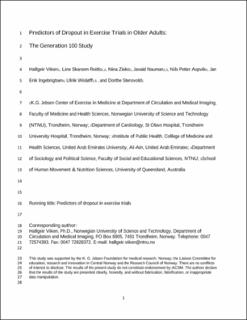Predictors of dropout in exercise trials in older adults: The generation 100 study
Viken, Hallgeir; Reitlo, Line Skarsem; Zisko, Nina; Nauman, Javaid; Aspvik, Nils Petter; Ingebrigtsen, Jan Erik; Wisløff, Ulrik; Stensvold, Dorthe
Peer reviewed, Journal article
Accepted version

Åpne
Permanent lenke
https://hdl.handle.net/11250/2651644Utgivelsesdato
2019Metadata
Vis full innførselSamlinger
Originalversjon
Medicine & Science in Sports & Exercise. 2019, 51 (1), 49-55. 10.1249/MSS.0000000000001742Sammendrag
Purpose
Dropout from exercise programs, both in the real world and in research, is a challenge, and more information on dropout predictors is needed for establishing strategies to increase the likelihood of maintaining participants in a prescribed exercise program. The aim of the present study was to determine the dropout rate and its predictors during a 3-yr exercise program in older adults.
Methods
In total, 1514 men and women (mean ± SD age = 72.4 ± 1.9 yr) were included in the present study. Participants were randomized to either a supervised exercise intervention or to follow national guidelines for physical activity (PA). Self-reported demographics (e.g., education), general health, morbidity (e.g., heart disease, memory loss, and psychological distress), smoking, and PA were examined at baseline. Cardiorespiratory fitness (CRF) and grip strength were directly measured at baseline. Dropout rate was evaluated after 1 and 3 yr. Multivariate logistic regression analysis was used to identify dropout predictors.
Results
The total dropout rate was 11.0% (n = 166) after 1 yr and 14.9% (n = 225) after 3 yr. Significant predictors of dropout after 1 yr were low education, low grip strength, lower cardiorespiratory fitness, low PA level, and randomization to supervised exercise. The same predictors of dropout were significant after 3 yr, with reduced memory status as an additional predictor.
Conclusion
This is the largest study to identify dropout predictors in a long-term exercise program in older adults. Our findings provide new and important knowledge about potential risk factors of dropout in long-term exercise programs in older adults.